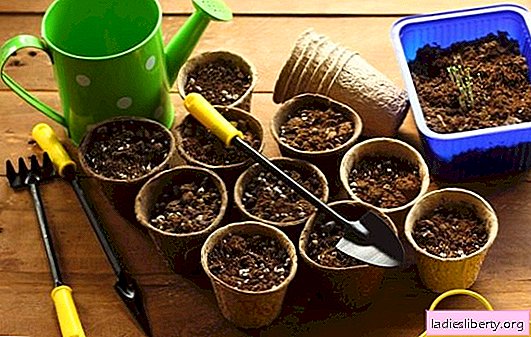
You need to think about growing vegetables in winter, since most of them are planted with seedlings. In order to take the crop on time, you need to know the exact timing of sowing.
What vegetables to grow through seedlings and why
A novice gardener asks the question of why to grow seedlings, if you can sow seeds directly into the ground. And this is partly true. In the southern regions of the country, most vegetable crops are sown in open ground. Seedling method is used in order to get an earlier crop. In addition, in regions with a warm climate, the seedling method of cultivation helps to get two waves of fruiting. Vegetables will sing until the frost.
In the central part of Russia, in the North and the Urals, growing vegetables without seedlings is unacceptable even in a greenhouse. Vegetables are sown here at home, and then transferred to the ground. This is due to the local climate, where the spring is long and cold, and the summer is short. Planting seeds immediately in the open ground of the crop can not wait.
Almost any vegetable crops and herbs can be grown in seedlings:
- celery;
- parsley;
- basil;
- tarragon;
- lemon balm;
- peppermint;
- eggplant;
- pepper;
- Tomatoes
- cauliflower and white cabbage;
- Beijing cabbage;
- pumpkin;
- zucchini;
- squash;
- bow.
This is not a complete list of cultures. However, some of them can be planted immediately in the ground. This gardener decides for himself, based on the region of cultivation.
What vegetables to plant for seedlings in January
In the middle of winter it’s too early to deal with landings, but it’s time for preparatory work. It is better now to purchase seeds, test them for germination, prepare containers and soil.
Late January you can already start sowing crops for early consumption. Their further cultivation will occur in greenhouses. These may be early varieties of cucumbers, tomatoes, greens.
What can be planted from vegetables for seedlings in February
At the beginning of the month, seeds of crops that sprout for a long time are prepared. In mid-February, they plan to plant vegetables for greenhouse cultivation.
February landing table
| Name of culture | Landing time |
| Root celery | 1.02-10.02 |
| Basil | 5.02-15.02 |
| Parsley | 5.02-15.02 |
| Peppers | 10.02-25.02 |
| Eggplant | 10.02-25.02 |
| Early cucumbers | 20.02-28.02 |
Important! In winter, the seedlings must be lightened up, otherwise it will stretch and become fragile.
What can be sown in March for seedlings
The beginning of spring expands the possibilities, here the gardeners are already embarking on the cultivation of seedlings, which can subsequently be planted in open ground.
March landing table
| Name of culture | Landing time |
| All kinds of cabbage | 1.03-10.03 |
| Bell pepper | 1.03-10.03 |
| Early tomatoes | 8.03-15.03 |
| Medium Tomatoes | 10.03-20.03 |
| Late tomatoes | 15.03-25.03 |
| Leek | 15.03-31.03 |
| Black onion | 10.03-31.03 |
What else can be sown from vegetables in April for seedlings
In April, they continue to sow crops that they did not manage to plant at the end of March, as well as vegetables for open ground and a greenhouse, greens and other heat-loving crops.
April sowing table
| Name of culture | Landing time |
| Marjoram | 1.04-10.04 |
| Melissa | |
| Hyssop | |
| Tarragon | |
| Basil | |
| Salad | 15.04-30.04 |
| Pumpkin | |
| Zucchini | |
| Squash | |
| Cucumbers | 20.04-30.04 |
In late April, in addition to planting, you can do the planting of finished seedlings in a greenhouse or greenhouse.
Terms of growing seedlings of vegetables: when to transplant into a greenhouse or open ground
When the time comes for transplanting seedlings, it depends on the growth rate, on weather conditions and the region of cultivation. In addition, there is an optimal age at which the seedlings tolerate the transplant quite well.
The table that shows the age of the finished seedlings for transplantation
| Name of culture | Seedling age |
| Tomatoes | 50 days for protected ground 60 days for open beds |
| Cucumbers | 20-25 days for open ground |
| Peppers | 55-60 days for open ground |
| Eggplant | 50-55 days for greenhouses 60 days for open beds |
| Early cabbage | 45-55 days for all types of landings |
| Medium cabbage | 35-45 days |
| Late cabbage | 45-50 days |
| Celery root | 65-75 days |
| Courgettes, squash | 25-35 days |
| Pumpkin | 20-30 days |
| Bow | 25-35 days |
How to transplant seedlings of vegetables in the soil
In order not to harm the young plant, it must be carefully transplanted. Here it is worth using the advice of experienced gardeners:
- A transplant is planned not earlier, when the earth warms up to 15 ° C at a depth of 10 cm.
- In cloudy weather, landing is carried out in the morning, and on a sunny day it is better to postpone work for the evening.
- After transplanting, young plants are covered for 3 days so that they adapt faster.
- Before planting, the bed is disinfected with a hot solution of potassium permanganate. For 1 square. m. use 1.5 liters of fluid.
- Fertilizers are added to the wells immediately before planting.
Attention! Before planting the main crop from the garden, you can harvest early greens and vegetables, such as radishes, lettuce. They need to be removed a week before transplanting seedlings.
Vegetable planting pattern
| Name of culture | Distance cm between plants in a row | Distance cm between rows |
| Tomatoes | 35-45 | 50-75 |
| Eggplant | 25-40 | 50-60 |
| Peppers | 30-40 | 60-70 |
| Cabbage | 40-50 | 50-70 |
| Courgettes, squash | 60-70 | 70-90 |
| Cucumbers | 15-20 | 60-90 |
| Bow | 15-20 | 50-70 |
Tomatoes are planted vertically, obliquely or in-depth. With a vertical planting method, plants are buried to cotyledon leaves or the first pair of true ones. The inclined method involves planting at an angle of 45 ° C relative to the soil, the stem of the tomato is buried by 15 cm. Overgrown tomato seedlings are planted in a buried way, while the stem is dug up by 15-17 cm.
Peppers and eggplant are planted vertically, maintaining height, as when growing seedlings.
All types of cabbage are planted vertically, but the stem is deepened to real leaves. This contributes to the formation of a firm head out.
Cucumbers are planted in a checkerboard pattern, while the depth of planting is maintained, as in pots. The stem is spudded as it grows so that the roots are not exposed.











